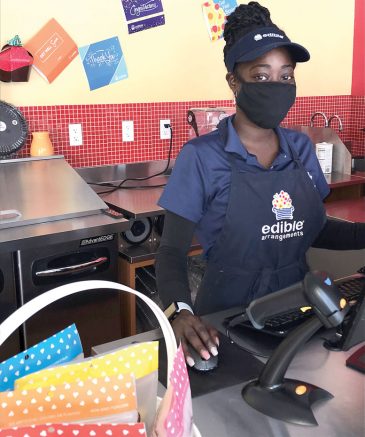Edible Brands – The Fruit, Veggie and Flower Ambassador
December 1, 2020 | 7 min to read
Amid the pandemic, Edible Arrangements thrived by launching new products and enhancing customer service, emphasizing the emotional connection food and flowers foster. With 2020 exceeding the $600 million earnings mark, they expanded offerings with popular whole fruit and vegetable boxes that addressed customer needs during lockdowns. President Cheikh Mboup recognized that orders reflected care rather than mere transactions, thereby fostering community ties. This approach positions Edible as an ambassador for produce, enhancing sales while delivering joy.

Originally printed in the November 2020 issue of Produce Business.
Embracing the challenges of the pandemic with new product launches and amped-up customer service, this company expanded its winning formula by nurturing the emotional connection food and flowers offer.
Supermarket, mass market and club stores could possibly view Edible Arrangements as a quick-service shop taking away produce and floral sales. But another perspective is to see the 21-year-old, Atlanta-based company as an ambassador of produce and floral, working one delivery at a time to boost the consumption and enjoyment of fruit, vegetables and flowers.
Even if you’ve never received a gift of chocolate dipped pineapple pieces or strawberries drizzled and dazzled or a fruit bouquet featuring grapes on picks accompanied by delicious wedges of wave-cut cantaloupe and honeydew melon, maybe you’ve seen the well-emblazoned vans zipping around town. They’re transporting fruit and flower deliveries prepared by local franchisees to delighted recipients in your communities.

Those photo-covered vans featuring luscious fruit bouquets are billboards on wheels, whetting proverbial whistles and stirring up appetites for something delicious — fruit. And no matter your perspective, that’s good for business if you’re in the business of selling produce.
Business IS big. In 2019, Edible Brands, the parent company of Edible, which is listed as the world’s largest franchisor of fresh fruit arrangements and all-natural fruit snacks and dipped treats, reported annual earnings of $600 million. This year, while the pandemic triggered franchisees to offer free delivery and curbside pickup instead of in-store purchases – while consumers were unabashedly ordering online goods and gifts at record levels, that $600 million mark was surpassed in September.
To paint the picture, January-through-June highlights include: best April sales in company history, up 38% YOY; best single sales month in company history in May, up 45% YOY; an all-time high Mother’s Day with more than 700,000 orders fulfilled; and best June sales in company history, up 55% YOY.
BACK TO BASICS
Especially notable to supermarkets, which didn’t have a chance to come up for air during the early months of the pandemic, an additional achievement of Edible Brands was the wise launch of whole fruit and produce boxes. These pure produce items in whole form – unadorned, cut or dipped — remain popular with customers seeking to send practical nourishment to friends and family.
Selling for $29.99, the basic fruit box contains a pineapple, bananas, grapes, strawberries, oranges and apples. Sometimes cantaloupe takes the place of the pineapple, and switches are made when necessary to maintain the high quality level.

When sales of the basic fruit box skyrocketed, Edible listened to customer feedback and online reviews and quickly offered a vegetable box and a fruit-and-veggie combo box. The idea was to feed people and deliver food as a thoughtful gift that recipients would welcome — especially as many were not able to shop in grocery stores during the early months of the pandemic.
Cheikh Mboup, president and chief operating officer of Edible Brands, is a strategist with vision who knows the value of building strong specialized teams. And he likes to feed people foods that have a wow factor. When asked about the pandemic and how the stay-at-home regulations resulted in a spike of online delivery orders, Mboup says the company recognized the flood of purchases as not just transactional, but rather orders that were more geared to share feelings.

The whole fruit box was launched March 13. “Whole fruit boxes helped the brand with keeping the emotional factor. We were able to wow people and keep our business focus,” says Mboup. He reveals the company saw customers ordering one box for themselves and sending four or five to others. “At that point, we saw the a-ha moment and knew more customers would appreciate the whole fruit boxes as essential product.”
WINNING FORMULA
Especially after a year when families have been unable to gather and celebrate happy occasions or travel to mourn the many losses, Edible Brands carved a niche by offering suitable products for an array of budgets and occasions. Strategically marketing the produce boxes, the company captured many first-time customers early in this pandemic year.
Social media played an important role in the marketing mix. During the early days of the pandemic, there were posts from gift-givers applauding the option of the basic fruit box as a deliverable gift. One example was about concern for a grandmother who lived on her own and was unable to leave her city apartment to go to the market for food as was her daily routine. The granddaughter could only imagine her grandmother sitting alone, so she turned to the Internet and placed an order. The Edibles delivery of the basic fresh fruit assortment relieved those worries for the granddaughter and delighted and fed the grandmother.

Posts similar to that are priceless testimonials, and Mboup is consistent with sharing the meaningful stories with his marketing and product development teams as well as franchisees. Other real-life accounts have opened Mboup’s eyes and heightened his previous awareness of the power of people enjoying food. He indicates the touching stories serve as reminders that feeding people ties all of us to each other. Especially in a period or age of isolation such as a pandemic, showing care, concern and love for others is an essential act.
GLOBAL REACH
Delighting people with food, treats, flowers and gifts is an international effort. Included in the 1,200 or so locations, Edible has a worldwide customer base beyond the United States, including franchises in Canada, United Arab Emirates, Saudi Arabia, Qatar, Dubai and China.
Franchisees place their own orders for produce using distributors that are required to meet stringent qualifications related to traceability. Mboup says franchisees order from the approved list of produce distributors, and delivery typically happens two to three times per week. Food Safety training is said to be a significant part of the education program developed specifically for franchisees.
No descriptions were shared about the special tools or equipment utilized to cut the fruit in the popular shapes, but it’s doubtful average cookie cutters are being used. Making the bouquets with all that cut fruit is labor-intensive, and it makes one wonder how long it will be before Mboup brings in robots for assistance.
EMOTIONAL CURRENCY
For retailers concerned the thousands of Edible Arrangements delivered every week are taking away from produce sales, fear not. Yes, the financially and emotionally invested franchisees are creatively cutting mango chunks and melons for 10-pack bundles of fruit cups to go. Yes, kids are probably trying fresh pineapples slices now more than in the past, thanks to extreme presentation skills and kid-size containers. All of this exposure to fruit and enjoyment of presented fruit fuels appetites and engages consumers of all ages – and they’re also your customers.
Perhaps you want to conduct your own experiment by visiting an Edibles store or placing an order or two. Experience the joy of sending fruit and treats to a loved one. And upon receiving your own delivery, pay attention to the wow factor of receiving a carefully-wrapped produce-centric gift. Feel the anticipation and delight of opening the flowers and treats, and taste for yourself how Edible Brands has become an ambassador for the very products sold in your stores.
Strong with analyzing performance metrics, Mboup explains tracking data is an act of “listening to the heartbeat in preparation for success.” The company acknowledges the person-to-person tie consumers have with food, and it increases the accessibility of giving and receiving. Mboup’s sensible label for all of this is emotional currency.
With bouquet sales it’s easy to recognize the alignment between human emotions and flowers. Receiving and giving flowers causes feelings of joy. Edible Brands furthers that connection by implementing a customer-minded strategy in sync with a world needing comfort, nourishment, and connection.
SMOOTHIES AS SOLUTIONS
Food waste, of course, is an international concern, but Edible Brands’ franchisees have a significant solution for all of those cut-away bits and pieces of fruit and ripe strawberries – fresh fruit smoothies. They’re made and sold in the stores and seem to make the shops a destination for customers who merely want a smoothie as a morning coffee replacement, an after-school treat, or a post-workout boost.
While waiting for the super blender to whirl away, smoothie customers see colorful posters of available products for all types of celebrations. They know a return trip is imminent.
22 of 26 article in Produce Business December 2020

